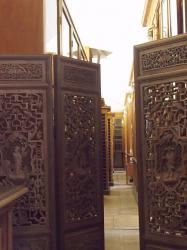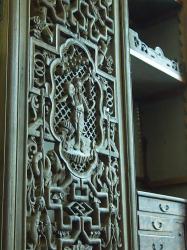Second Half of the 19th Century: Eastern Manuscripts
The second half of the 19th century saw a significant influx of Eastern manuscripts into the library.
To this day, the most significant acquisition in term of size (18 000 items) remains the collections of the famous Karaite writer and cleric, traveler, antiquarian and archaeologist Abraham Firkovich. In 1862–1863, the Library bought his first collection containing one and a half thousand books, scrolls and documents in Hebrew. They were gathered both in the Russian Empire and in the Middle East. On behalf of the Karaite community of Crimea, Firkovich undertook a number of trips around the Crimea in 1839 and 1851 and to the Caucasus in 1840 to discover manuscripts concerning the history of his people.For some time his finds was stored by the Odessa Society of History and Antiquities in the Odessa museum. In 1863, they were transported to St. Petersburg, as part of the already purchased collection. The collector again went to the Middle East — first to Palestine, where he managed to buy from the Samaritan community of Nablus more than a thousand written landmarks of this small nation. The Samaritan collection was acquired by the Library in 1870.
Then Firkovich visited Cairo, where he bought from the Karaite community worn-out fragmentary manuscripts of the 10th – 15th centuries in Hebrew and Arabic. These manuscripts were found in the storeroom of the Ben Ezra Synagogue - genisah. The significance of these landmarks of the medieval Jewish culture of the East is difficult to overestimate: among them are many previously unknown works in all branches of knowledge, unique sources on the history of not only the Jewish people, but also its neighbors. The second collection of Firkovich (15 thousand items) and his personal archive were purchased in 1876.
Muslim manuscripts were also actively acquired, the most valuable acquisitions came in the Library due to the collecting activities of Russian diplomats — plenipotentiary ministers at the Persian court D. Dolgorukov, I. Simonich (1868) and the consul in Tabriz, the famous orientalist N. Khanykov (1864). In 1864, the Library purchased the collection of ancient Kufic Qur'ans, consiting of 130 fragments dating from the 8th to 11th centuries, gathered by the French Arabist, member of the Napoleon expedition to Egypt Jan Joseph Marcel. Professor of the St. Petersburg University V. Smirnov visited Turkey in 1875, 1879 and 1893 to buy Muslim manuscripts at the expense of the Library.
The expansion of the borders of Russia in Central Asia contributed to the growth of stocks. Between 1868 and 1876, the first Governor-General of Russian Turkestan Konstantin von Kaufman transferred 300 Arabographic manuscripts and two archives of the Khiva and Kokand khans to the Library. In 1962, by decision of the Ministry of Culture of the RSFSR, the archives were returned to Uzbekistan.The last decades of the nineteenth century saw numerous acquisitions of Christian manuscripts created in Eastern countries. In 1880, the Library bought a collection of Prince Ioane of Georgia from his grandson Prince Ivan Gruzinsky. It comprised 360 handwritten books as well as documents from the time of Georgia’s accession to Russia. In 1923, by decision of the Soviet Government, the Library transferred 216 Georgian manuscripts, including 178 items from the collection of Prince Ioane of Georgia and 39 items from other collections — to Georgia. Now these manuscripts are housed in the Manuscript Institute in Tbilisi.
The collection of Oriental manuscripts, inherited from Petersburg University Professor I. Minaev, was the largest private donation to the Library. During his three tours to India, Minaev assembled 320 Indian manuscripts, 75 of them were written on palm leaves.
The collection of the Head of the Russian Ecclesiastical Mission in Jerusalem Archimandrite Antonin (Kapustin), acquired in 1899, comprises Arabic and more than a thousand Jewish manuscript books and fragments from the Ben Ezra Synagogue in Old Cairo.

